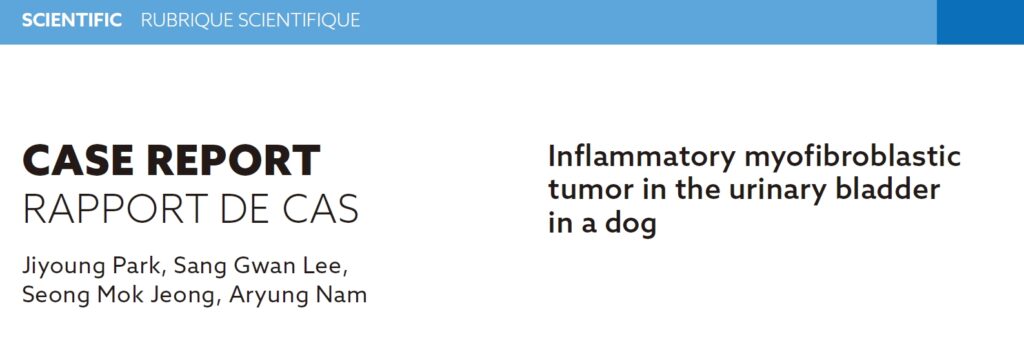
| 一般情况 | |
|---|---|
| 品种:马尔济斯犬 | |
| 年龄:8岁 | |
| 性别:雄 | |
| 是否绝育:是 | |
| 诊断:膀胱炎性肌成纤维细胞瘤 | |
01 主诉及病史
因膀胱肿块和泌尿系统结石转诊接受手术治疗。
转诊前两周,出现多尿和血尿症状。曾口服阿莫西林-克拉维酸(12.5 mg/kg q12h)7天,但症状没有改善。
3年前,曾因草酸钙性尿路结石接受过膀胱切开术。之后一直食用处方粮(Hill’s c/d Multicare)。术后4个月膀胱结石复发,并患有间歇性慢性膀胱炎。2年前,被诊断患有免疫介导的血小板减少症,经过治疗后,相关药物已经停用。
02 检查
体重7.2千克。精神状态良好。白细胞轻度增多(21.0×10^9/L [6-17])、血小板减少(131×10^9/L [200-500])。C反应蛋白正常(5 mg/L [0-10])。碱性磷酸酶升高(298 U/L [23-212])。凝血功能正常。
胸部/腹部X光平片显示,膀胱和尿道近端有尿路结石。腹部超声显示,膀胱三角附近有一个梗阻性肿块(2.8×1.6 cm),中心低回声,周边高回声(下图A)。肿块颈部宽7 mm,距离左侧输尿管开口1 cm。肿块没有侵犯膀胱肌层,也没有淋巴结肿大或膀胱外病变。膀胱壁前部不规则增厚(6 mm)。双对比膀胱造影显示,一个不规则的卵圆形肿块与背侧膀胱壁相连,肿块柄较短,膀胱内腔呈不规则线状(下图B)。
↑ 超声图(A)和双重对比膀胱造影(B)。在(B)中,三角所指为膀胱结石;箭头所指为有蒂肿块的颈部。
03 治疗
全麻下,通过膀胱切开术取出了3块膀胱结石。肿块稍坚硬,但粘膜附着物柔软且可移动,通过切口将其切除,包括与膀胱连接处周围5 mm的正常粘膜区域(下图AB)。将膀胱的头腹部向内翻转,发现粘膜表面不规则,有多个突起(下图C)。因此,对其进行了切开全层活检。肿块的不规则粘膜表面有几个息肉状突起,并有一个深色的瘀血区,怀疑是出血部位。肿块的长轴为3.5 cm。切开表面可以看到淡粉色、柔软易碎的边缘和相对坚硬、致密的乳白色中心(下图D)。
↑ 虚线(B)表示切除线;细箭头(B)指向有蒂肿块的颈部;粗箭头(BD)显示了可能造成血尿的淤血点。
经组织病理学检查(下图AB),肿块外表面的小结节状突起由分化良好的尿路上皮细胞组成,上覆疏松、水肿、纤维血管结缔组织细胞。上皮细胞偶尔会侵入下层浅粘膜下层,并形成Brunn’s巢。在深层粘膜下层和浅层的逼尿肌内,有一个离散的中度细胞团,由丰满的纺锤形细胞组成,可解释为肌成纤维细胞或成纤维细胞表型。它们排列成界限不清的束状和簇状,与明显浸润的成熟小淋巴细胞、浆细胞以及数量较少的组织细胞、嗜酸性粒细胞和中性粒细胞混杂在一起。肿块由小口径血管支撑。非典型纺锤形细胞对波形蛋白和desmin蛋白呈强免疫反应(下图CD),但对平滑肌肌动蛋白呈阴性(下图E)。少数纺锤体细胞对Calponin蛋白的免疫反应非常微弱(下图F)。最终确诊为炎性肌成纤维细胞瘤。全厚透壁活检样本显示慢性溃疡性膀胱炎,其特点是粘膜溃疡和粘膜下肉芽组织形成。
04 预后
术后第3天出院,没有出现任何排尿问题。术后症状完全缓解,至今没有发现肿块复发或尿路结石。
术后43个月,仍然表现良好。
05 讨论
犬膀胱肿瘤中有90%是上皮性的,其中大多数是侵袭性和浸润性尿路上皮癌(urothelial carcinoma,UC)[1]。将非UC肿瘤或非肿瘤性病变与UC区分开来至关重要,因为治疗方法和预后大不相同[2]。这些疾病可出现类似的非特异性临床症状,包括血尿、少尿、多尿、尿痛或尿路梗阻[2]。因此,明确诊断需要对肿块进行组织病理学检查。
炎性肌成纤维细胞瘤(Inflammatory myofibroblastic tumor,IMT)最早被描述为人类肺部炎症后的一种修复性疾病[3]。这些肿瘤常见于儿童和年轻人,发病率为0.04%-0.7%[4,5]。其病因尚不完全清楚,手术史、创伤、慢性感染或免疫介导过程都与这些肿瘤的发生有关[6,7]。尽管膀胱IMT非常罕见,而且有可能被误诊,但仍有关于人类膀胱IMT的病例记录和回顾性研究[8,9]。
IMT是一种罕见的肿瘤,具有中等生物潜能,属于炎性纺锤形细胞病变[10]。这些肿块的主要细胞成分为肿瘤细胞、成纤维细胞和肌成纤维细胞,有丝分裂活性有限,无异常有丝分裂图形,伴有不同比例的浆细胞、淋巴细胞、组织细胞的炎性浸润,偶尔还有嗜酸性粒细胞或中性粒细胞[6,11-13]。
肌成纤维细胞是一种细胞表型,同时具有平滑肌细胞和成纤维细胞的特征,可产生胶原蛋白并负责组织修复,如伤口愈合[14,15]。肌成纤维细胞分泌的细胞因子是炎症细胞的趋化因子,可能导致炎症细胞浸润肿瘤组织[16,17]。
过去,IMT被认为是炎性假瘤的一个亚类,“IMT”和“炎性假瘤”这两个术语经常被交替使用[12]。不过需要注意的是,炎性假瘤是一种炎症反应性或再生性较强的病变,通常可以保守治疗[18]。它是一种纺锤形细胞增生,炎症浸润与IMT相似,但它不会复发或转移,因此应与IMT区别开来[12,18]。
相反,一些IMT病例表现出侵袭性行为和ALK基因重排的分子表达[10,17]。因此,IMT被归类为一种独特的肿瘤,具有复发率高但转移潜力低的特点[12]。据报道,IMT的局部复发率高达25%,远处转移率为5%[19]。
犬IMT很少见于泪腺、心脏、脊柱、鼻腔和胰腺[7,13,30-32]。此外,有两篇报告描述了膀胱内的IMT,其特征为单个或多个结节状、管腔内、息肉状和坚硬的肿块,伴有明显血尿和偶发性腹痛[6,33]。
在本病例中,该犬既有膀胱切开术史,又有复发性尿路结石,这可能是膀胱壁受到慢性机械性刺激超过3年所致。手术切除肿块和尿路结石后,多尿和血尿症状消失,术后长达43个月未再出现临床或排尿问题。
此前关于犬膀胱内IMT的报道结果良好,无论手术切除是否彻底,临床症状均完全缓解,且无复发[6,33]。在人类中,手术是治疗膀胱内IMT最有效的方法,且预后良好[8,9]。对于切除不彻底或复发的病例,可选择其他治疗方法,如放疗、化疗和皮质类固醇[34]。
一只患有脑膜IMT的马耳他犬通过不完全手术切除和持续2.5年的泼尼松龙治疗获得了成功[35]。在另一个病例中,一只小猫在脾脏IMT脾切除术后2个月出现局部复发,使用泼尼松后症状得到有效缓解[36]。
总之,本报告描述了一只患有膀胱IMT的犬,该犬通过手术完全切除了膀胱IMT,并且在超过43个月的时间里没有复发。犬膀胱内IMT虽然罕见,但应将其列入膀胱肿块的鉴别诊断中,尤其是当犬患有与尿路结石或慢性炎症相关的慢性机械性刺激时。
文献来源:Park J, Lee SG, Jeong SM, Nam A. Inflammatory myofibroblastic tumor in the urinary bladder in a dog. Can Vet J. 2024 Jul;65(7):643-648.
参考文献
1.Meuten DJ, Meuten TLK. Tumors of the urinary system. In: Meuten DJ, editor. Tumors in Domestic Animals. 5th ed. Cary, North Carolina: Wiley Blackwell; 2017. pp. 632–688.
2.Knapp DW, McMillan SK. Tumors of the urinary system. In: Withrow SJ, Vail DM, Page RL, editors. Withrow & MacEwen’s Small Animal Clinical Oncology. 5th ed. St. Louis, Missouri: Elsevier Saunders; 2013. pp. 572–582.
3.Brunn H. Two interesting benign lung tumors of contradictory histopathology. J Thorac Surg. 1939;9:119–131.
4.Golbert ZV, Pletnev SD. On pulmonary “pseudotumours”. Neoplasma. 1967;14:189–198.
5.Cerfolio RJ, Allen MS, Nascimento AG, et al. Inflammatory pseudotumors of the lung. Ann Thorac Surg. 1999;67:933–936.
6.Böhme B, Ngendahayo P, Hamaide A, Heimann M. Inflammatory pseudotumours of the urinary bladder in dogs resembling human myofibroblastic tumours: A report of eight cases and comparative pathology. Vet J. 2010;183:89–94.
7.Swinbourne F, Kulendra E, Smith K, Leo C, Ter Haar G. Inflammatory myofibroblastic tumour in the nasal cavity of a dog. J Small Anim Pract. 2014;55:121–124.
8.Teoh JY, Chan NH, Cheung HY, Hou SS, Ng CF. Inflammatory myofibroblastic tumors of the urinary bladder: A systematic review. Urology. 2014;84:503–538.
9.Chen C, Huang M, He H, et al. Inflammatory myofibroblastic tumor of the urinary bladder: An 11-year retrospective study from a single center. Front Med. 2022;9:831952.
10.Gleason BC, Hornick JL. Inflammatory myofibroblastic tumours: Where are we now? J Clin Pathol. 2008;61:428–437.
11.Sakurai H, Hasegawa T, Watanabe Si, Suzuki K, Asamura H, Tsuchiya R. Inflammatory myofibroblastic tumor of the lung. Eur J Cardiothorac Surg. 2004;25:155–159.
12.Siemion K, Reszec-Gielazyn J, Kisluk J, Roszkowiak L, Zak J, Korzynska A. What do we know about inflammatory myofibroblastic tumors? A systematic review. Adv Med Sci. 2022;67:129–138.
13.Knight C, Fan E, Riis R, McDonough S. Inflammatory myofibroblastic tumors in two dogs. Vet Pathol. 2009;46:273–276.
14.Chitturi RT, Balasubramaniam AM, Parameswar RA, Kesavan G, Haris KM, Mohideen K. The role of myofibroblasts in wound healing, contraction and its clinical implications in cleft palate repair. J Int Oral Health. 2015;7:75–80.
15.Koga M, Kuramochi M, Karim MR, Izawa T, Kuwamura M, Yamate J. Immunohistochemical characterization of myofibroblasts appearing in isoproterenol-induced rat myocardial fibrosis. J Vet Med Sci. 2019;81:127–133.
16.Bagalad BS, Mohan Kumar KP, Puneeth HK. Myofibroblasts: Master of disguise. J Oral Maxillofac Pathol. 2017;21:462–463.
17.Hagenstad CT, Kilpatrick SE, Pettenati MJ, Savage PD. Inflammatory myofibroblastic tumor with bone marrow involvement. A case report and review of the literature. Arch Pathol Lab Med. 2003;127:865–867.
18.Höhne S, Milzsch M, Adams J, Kunze C, Finke R. Inflammatory pseudotumor (IPT) and inflammatory myofibroblastic tumor (IMT): A representative literature review occasioned by a rare IMT of the transverse colon in a 9-year-old child. Tumori. 2015;101:249–256.
19.Yamamoto H. Soft Tissue and Bone Tumours WHO Classification of Tumours. 5th ed. Lyon, France: International Agency For Research on Cancer; 2020. pp. 109–111.
20.Martinez I, Mattoon JS, Eaton KA, Chew DJ, DiBartola SP. Polypoid cystitis in 17 dogs (1978–2001) J Vet Intern Med. 2003;17:499–509.
21.Takiguchi M, Inaba M. Diagnostic ultrasound of polypoid cystitis in dogs. J Vet Med Sci. 2005;67:57–61.
22.Hamlin AN, Chadwick LE, Fox-Alvarez SA, Hostnik ET. Ultrasound characteristics of feline urinary bladder transitional cell carcinoma are similar to canine urinary bladder transitional cell carcinoma. Vet Radiol Ultrasound. 2019;60:552–559.
23.Fuller TW, Dangle P, Reese JN, et al. Inflammatory myofibroblastic tumor of the bladder masquerading as eosinophilic cystitis: Case report and review of the literature. Urology. 2015;85:921–923.
24.Webb KL, Stowe DM, DeVanna J, Neel J. Pathology in practice. J Am Vet Med Assoc. 2015;247:1249–1251.
25.Knapp DW, Ramos-Vara JA, Moore GE, Dhawan D, Bonney PL, Young KE. Urinary bladder cancer in dogs, a naturally occurring model for cancer biology and drug development. ILAR J. 2014;55:100–118.
26.Liu S, Yuan R, Jin Y, He C, Zheng X, Zhan Y. Clinicopathological features of inflammatory myofibroblastic tumor in the breast. Breast J. 2022;2022:1863123.
27.Telugu RB, Prabhu AJ, Kalappurayil NB, Mathai J, Gnanamuthu BR, Manipadam MT. Clinicopathological study of 18 cases of inflammatory myofibroblastic tumors with reference to ALK-1 expression: 5-year experience in a tertiary care center. J Pathol Transl Med. 2017;51:255–263.
28.Doyle LA, Hornick JL. Immunohistochemistry of neoplasms of soft tissue and bone. In: David J, editor. Diagnostic Immunohistochemistry. 5th ed. Philadelphia, Pennsylvania: Elsevier; 2019. pp. 82–136.
29.Lai R, Ingham RJ. The pathobiology of the oncogenic tyrosine kinase NPM-ALK: A brief update. Ther Adv Hematol. 2013;4:119–131.
30.Tursi M, Garofalo L, Muscio M, et al. Verrucoid lesions of mitral valve in a dog with features of inflammatory myofibroblastic tumor. Cardiovasc Pathol. 2009;18:315–316.
31.Kuniya T, Shimoyama Y, Sano M, Watanabe N. Inflammatory pseudotumour arising in the epidural space of a dog. Vet Rec Case Rep. 2014;2:e000095.
32.Romanucci M, Defourny SV, Massimini M, et al. Inflammatory myofibroblastic tumor of the pancreas in a dog. J Vet Diagn Invest. 2019;31:879–882.
33.Rocha NS, Tostes R, Ranzani JJT, Schmidt F. Inflammatory pseudotumor of the urinary bladder in dogs: Two cases. Arquivo Brasileiro de Medicina Veterinaria e Zootecnia. 2002;54:450–453.
34.Narla LD, Newman B, Spottswood SS, Narla S, Kolli R. Inflammatory pseudotumor. Radiographics. 2003;23:719–729.
35.Loderstedt S, Walmsley GL, Summers BA, Cappello R, Volk HA. Neurological, imaging and pathological features of a meningeal inflammatory pseudotumour in a Maltese terrier. J Small Anim Pract. 2010;51:387–392.
36.Ferro S, Chiavegato D, Fiorentin P, Zappulli V, Di Palma S. A recurrent inflammatory myofibroblastic tumor-like lesion of the splenic capsule in a kitten: Clinical, microscopic and ultrastructural description. Vet Sci. 2021;8:275.